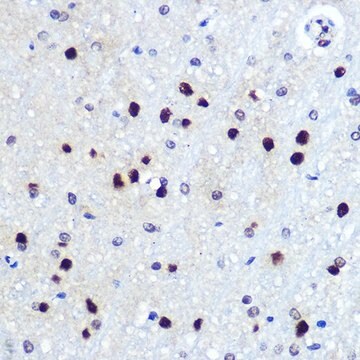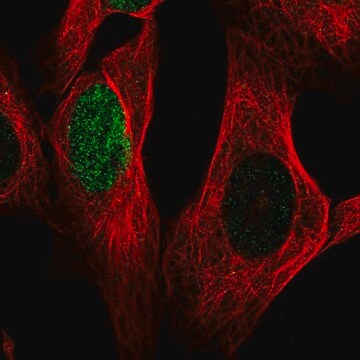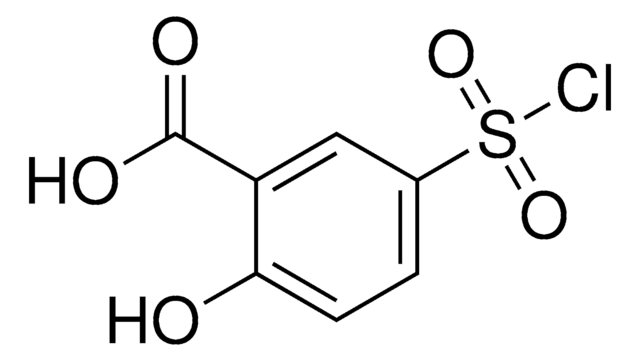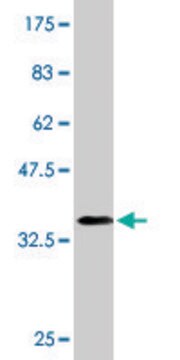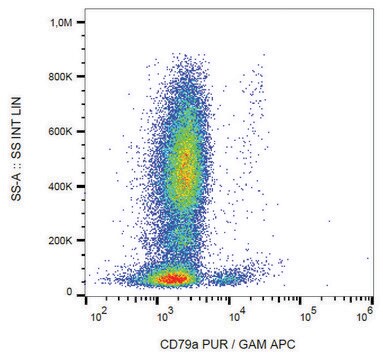詳細
We are committed to bringing you greener alternative products, which adhere to one or more of The 12 Principles of Green Chemistry. This antibody is Preservative-free, produced without the harm or sacrifice of animals and exceptionally stable to allow for ambient shipping and storage if needed and thus aligns with "Waste Prevention", "Designing Safer Chemicals" and "Design for Energy Efficiency".
Click here for more information.
ZooMAb® antibodies represent an entirely new generation of recombinant monoclonal antibodies. Each ZooMAb® antibody is manufactured using our proprietary recombinant expression system, purified to homogeneity, and precisely dispensed to produce robust and highly reproducible lot-to-lot consistency. Only top-performing clones are released for use by researchers. Each antibody is validated for high specificity and affinity across multiple applications, including its most commonly used application. ZooMAb® antibodies are reliably available and ready to ship when you need them.
特異性
Clone 2J12 is a ZooMAb® rabbit recombinant monoclonal antibody that specifically detects Transcription factor HES-1. It targets an epitope within 15 amino acids from the C-terminal region.
免疫原
KLH-conjugated linear peptide corresponding to 15 amino acids from the C-terminal region of human Transcription factor HES-1.
アプリケーション
Quality Control Testing
Evaluated by Western Blotting in HEK293 cell nuclear extract.
Western Blotting Analysis: A 1:10,000 dilution of this antibody detected HES-1 in HEK293 cell nuclear extract.
Tested Applications
Western Blotting Analysis: A 1:10,000 dilution from a representative lot detected HES-1 in SK-BR3 cell nuclear extract.
Immunohistochemistry (Paraffin) Analysis: A 1:100 dilution from a representative lot detected HES-1 in Human thyroid tissue sections.
Flow Cytometry Analysis: 0.1 µg from a representative lot detected HES-1 in one million SK-BR-3 cells.
Immunocytochemistry Analysis: A 1:100 dilution from a representative lot detected HES-1 in MCF-7 and SK-BR-3 cells.
Affinity Binding Assay: A representative lot of this antibody bound HES-1 peptide with a KD of 7.0 x 10-9 in an affinity binding assay.
Note: Actual optimal working dilutions must be determined by end user as specimens, and experimental conditions may vary with the end user.
ターゲットの説明
Transcription factor HES-1 (UniProt: Q14469; also known as Class B basic helix-loop-helix protein 39, bHLHb39, Hairy and enhancer of split 1, Hairy homolog, Hairy-like protein, hHL) is encoded by the HES1 (also known as BHLHB39, HL, HRY) gene (Gene ID: 3280) in human. HES-1 acts as a transcriptional repressor of genes that require basic helix-loop-helix (bHLH) protein for their transcription. It plays a role in several physiological processes, including cell differentiation, cell cycle arrest, and apoptosis. It is expressed in high levels in undifferentiated neural precursor cells and its levels decline with neural differentiation. It also acts as a negative regulator of myogenesis by inhibiting the function of Myogenic Differentiation 1 (MYOD1) and transcription regulatory protein ASH1. HES-1 also serves as a relevant mediator of the NOTCH signaling pathway in cancer where NOTCH pathway, through HES-1, is reported to contribute to the stabilization of the epithelial phenotype of bladder cancer cells. Low levels of HES-1 correlate with more aggressive bladder cancer and associate with mesenchymal features and invasive properties. However, HES1 levels are upregulated in poorly differentiated cancers compared with well-differentiated tumor samples and most adenocarcinomas display higher levels of HES1 mRNA. Its expression is correlated with the expression of stem cell markers in colon cancers, and it upregulates the expression of stemness-related genes in colon cancer cells. HES-1 contains a bHLH domain (aa 34-91), Orange domain (aa 110-143), and a C-terminal WRPW (Trp-Arg-Pro-Trp) motif (aa 275-278). The bHLH, as well as cooperation between the central Orange domain and the C-terminal WRPW motif, are reported to be essential for its transcriptional repressor activity. Within the bHLH region, HES-1 has a proline residue that exhibits unique binding ability to the N box (CACNAG), differing from other bHLH factors that have higher affinity to E box (CANNTG). This ZooMAb® recombinant monoclonal antibody, generated by our propriety technology, offers significantly enhanced specificity, affinity, reproducibility, and stability over conventional monoclonals. (Ref.: Maraver, A et al., (2015). J. Clin. Invest. 125(2); 824-830; Liu, Z-H., et al. (2015). Cancer Biol. Ther. 16(3); 353-359; Gao, F., et al. (2014). Sci. Rep. 4; Article 3963).
物理的形状
Purified recombinant rabbit monoclonal antibody IgG, lyophilized in PBS, 5% Trehalose, normal appearance a coarse or translucent resin. The PBS/trehalose components in the ZooMAb formulation can have the appearance of a semi-solid (bead like gel) after lyophilization. This is a normal phenomenon. Please follow the recommended reconstitution procedure in the data sheet to dissolve the semi-solid, bead-like, gel-appearing material. The resulting antibody solution is completely stable and functional as proven by full functional testing. Contains no biocide or preservatives, such as azide, or any animal by-products. Larger pack sizes provided as multiples of 25 µL.
保管および安定性
Recommend storage of lyophilized product at 2-8°C; Before reconstitution, micro-centrifuge vials briefly to spin down material to bottom of the vial; Reconstitute each vial by adding 25 µL of filtered lab grade water or PBS; Reconstituted antibodies can be stored at 2-8°C, or -20°C for long term storage. Avoid repeated freeze-thaws.
その他情報
Concentration: Please refer to the Certificate of Analysis for the lot-specific concentration.
法的情報
ZooMAb is a registered trademark of Merck KGaA, Darmstadt, Germany
免責事項
Unless otherwise stated in our catalog or other company documentation accompanying the product(s), our products are intended for research use only and are not to be used for any other purpose, which includes but is not limited to, unauthorized commercial uses, in vitro diagnostic uses, ex vivo or in vivo therapeutic uses or any type of consumption or application to humans or animals.




